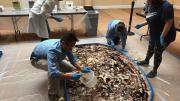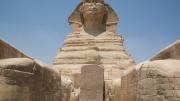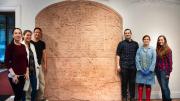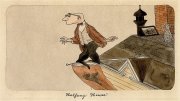“Fun with goo!” chirped Peter Der Manuelian, director of the Harvard Semitic Museum, observing the activity in its third-floor gallery. Kneeling on the floor, three student volunteers in protective coats and blue latex gloves smeared a grainy, salmon-colored paste over a rubbery template shaped like a tombstone. Theirs was the first shift of a museum project undertaken over three days in late October: casting a replica of the Dream Stele, an ancient Egyptian artifact dating back to about 1400 B.C.E. They moved quickly to distribute the resin with just the right unevenness over the blue silicone mold.
The project is part of Manuelian’s efforts to revitalize the Semitic Museum to appeal to a twenty-first-century audience. The building dates back to 1903, a time when museums bought plaster casts of ancient objects to teach students and visitors about Near Eastern archaeology and culture. Over time, better-resourced institutions like the Metropolitan Museum of Art, the Museum of Fine Arts in Boston, and the Louvre got rid of their replicas and acquired original reliefs and sculptures. Harvard bought up many of those copies, including one lot containing 150 Mesopotamian palace reliefs. Today, though, the casts are too heavy, and flake too easily, to go on display. They live in the fourth-floor attic and in off-site storage, swaddled in protective foam.
Assistant curator Adam Aja came up a way to make copies of these copies: cleaning up the old casts, painting them with silicone, and then pouring a resin into the resulting molds. The replicas “capture all of the details,” enthuses Manuelian. “Everything is there, plus they're lightweight—and once you have a mold, you can make a ton of ’em.” And, he adds, “It's a pretty cool way of bringing back to life the kind of thing that ISIS is smashing and destroying. They break ’em, we make ’em.”
In 2015, using Aja’s method and the efforts of students in the General Education course “Ancient Lives,” the museum made resin copies of some of those Mesopotamian reliefs. These will be hung around the perimeter of the third floor, itself in the midst of refurbishment. Recently, it’s gotten a new floor of polished concrete (protected by cardboard during the fun with goo); samples of possible paint colors—both gray—leaned against the walls. “One day,” says the museum director, “this will be a combination of Mesopotamian gallery and an event space. We’ll do weddings—we’ll do whatever!”
Manuelian is also King professor of Egyptology and founding director of the Giza Archives, and when he learned that the University of Leuven, in Belgium, was planning to restore its plaster cast of the Dream Stele, he proposed that they try Aja’s new technique. Last August, Aja went to Belgium and, after helping the Egyptologists there fix the damage to the plaster, made a mold and shipped it back to Cambridge. Then the assistant curator got to tinkering with different color shades to get just the right hue for the replica.
Supervising the students’ work, Aja instructed, “Don’t forget to paint it right up the sides. It’s going to drip and drain a bit.” He whipped up another batch of resin, adding pink powder a bit at a time, saying, “It can go bad fast.” Even with mica and aggregate mixed in, that main color alone would look unconvincingly flat, so the students left the base layer deliberately patchy to let other pigments—a white layer, then a black one—show through, lending depth and texture. “It’s okay if it clumps,” Aja told later shifts, paintbrush in hand. “We’re trying to create the illusion of an organic —well,” he corrected, “not organic, but volcanic—you’re creating this flow, this movement of color.”
Once it hardened, the resin stele looked wetly shiny from the back, its surface spotted like a shower stall overgrown with something fungal and toxic. “You're not quite sure what you're going to get until you lift it up,” explained Aja. “It's like a holiday present.” For the front of the stele, the museum staff was aiming for the matte, flecked blush of natural stone—something that could pass for the pink granite that King Thutmose IV ordered hauled from quarries in Aswan, some 400 miles south of Cairo, in the New Kingdom era. After they lifted the replica from the mold, they might need to touch it up a bit, bringing out this or that color, and toning down places where the edges of the carved figures looked too strong—but they’d have a solid canvas to work with.
The actual Dream Stele stands between the paws of the Great Sphinx at Giza. Though the Semitic Museum’s copy stands eight feet tall, and is composed of two parts, the original stele has a third, base, section, its hieroglyphs long since eroded. (These days, casts have more legible characters than the real thing does.) At the stele’s top, a curved lunette features the disc of a winged sun, and a pair of “offering scenes” which show the king pouring libations and burning incense to the god. The columns of hieroglyphs below tell of how Thutmose IV, then a young prince—and not even next in line to the throne—took a nap in the shadow of the Sphinx’s head. A vision appeared to him when the sun reached its zenith: the god spoke, promising that he would be king if he cleared away the sand that had accumulated at the Sphinx’s base. According to legend, it told him, “My face belongs to you; my heart belongs to you; and you belong to me.”
“Did it ever happen? Probably not,” says Manuelian. “It's a piece of royal propaganda, to bestow legitimacy on the throne. But it's a pretty romantic story, and it's pretty unique.” Nothing in ancient Egypt is quite like this artifact, he says. Other kings’ stelai tend to commemorate feats of empire-building, or the construction of temples. Thutmose IV went even further in making his mark, restoring some of the Sphinx itself and building an enclosure wall. It became something of a pilgrimage site, Manuelian adds, and non-royal people contributed their own, smaller monuments to the surrounding area. “Of the New Kingdom kings who returned to Giza, he was one of the most active.”
Once completed, the resin copy will be installed in the Semitic Museum’s second-floor Egyptian wing, the first thing visitors will see on their left when they enter. But even though having the stele in the gallery is all well and good, says Manuelian, without the original context, “you’re kind of losing it”—“it” being, perhaps, a sense of physical scale or grandeur, or the weight of time and sand. The museum plans to bolster the experience with an augmented reality app, and aims to open the display in its entirety sometime in February.
“We don't have some of the masterpieces that, say, the Metropolitan does, or the MFA,” says Manuelian. “So my view is, let's enhance what we do have with technology as an educational tool, to make it exciting, make it immersive.” He imagines the museum hosting undergraduate parties or even sleepovers in the galleries, resurrecting these dead civilizations using augmented or virtual reality, or letting students handle reproductions. “I’m open to anything.”
He does have his own dream projects. During a recent tour of the museum, he pulled up print-outs featuring two Mesopotamian antiquities held by the Louvre: a 12-foot winged bull with a human head (a protective genie often placed to guard city entryways), and a 16-foot Gilgamesh-ish hero spirit with an indignant lion crammed in the crook of his arm. Resources permitting, one day he’d like to fabricate replicas that would welcome visitors to the gallery—this time, using 3-D scanning and replication, rather than Aja’s analog methods. “Imagine having your fundraising dinner with this guy looking down at you,” Manuelian said with a broad grin. Putting the papers away, his voice dropped to a determined mutter. “Someday I'm going to make that happen. It'll be a big splash.”
Follow Sophia Nguyen @sophiah_n.











